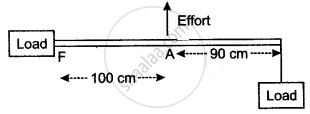Advertisements
Advertisements
प्रश्न
A crowbar of length 100 cm is used to lift a load of 5 kgf. It has its fulcrum at a distance of 20 cm from the load. Calculate:
(i) the mechanical advantage of a crowbar and,
(ii) the effort applied at the other end.
उत्तर
Given: L = 5 kgf, Load arm = 20 cm, Effort arm = 100 – 20 = 80 cm.
(Since the crowbar is the lever of first order with the fulcrum in between the load and the effort).
(i) Mechanical advantage =`("Effort arm")/("Load arm")=80/20=4`
(ii) M.A. =`"Load(L)"/"Effort(E)"`
∴ Effort =`"Load(L)"/"M.A."=5/4`
= 1.25 kgf.
APPEARS IN
संबंधित प्रश्न
What is a lever?
Give one example of a class I lever where mechanical advantage is more than one ?
Draw a diagram of a lever which is always used as a force multiplier. How is the effort arm related to the load arm in such a lever?
A lever of length 9 cm has its load arm 5 cm long and the effort arm is 9 cm long.
- To which class does it belong?
- Draw a diagram of the lever showing the position of fulcrum F and directions of both the load L and effort E.
- What is the mechanical advantage and velocity ratio if the efficiency is 100%?
- What will be the mechanical advantage and velocity ratio if the efficiency becomes 50%?
Give three examples for leavers of 1st order.
The following belong to which class of lever?
A see-saw
The following belong to which class of lever?
Rowing of a boat
The diagram shows the use of a lever.

- State the principle of moments as applied to the above lever.
- Which class of lever is this? Give an example of this class of lever.
- If FA = 100 cm, AB = 90 cm, calculate the minimum effort required to lift the load.
State the types (or kinds) of lever, and give two examples of each kind.
The length of a nut-cracker is 12 cm. A nut, when kept at a distance of 4 cm from its fulcrum, requires an effort of 100 gf to crack it. What force will be required to crack the nut without using the nut-cracker?
